The Best Cinnamon Rolls with Cream Cheese Frosting
This website contains affiliate links.
Some of the links below are affiliate links. This means that, at no additional cost to you, Bread By Elise may earn a commission if you click through the link and finalize a purchase. Please read our Privacy Policy for more details.
These Homemade Cinnamon Rolls are extra buttery and fluffy, packed with layers of cinnamon-sugar goodness that caramelize to perfection, coating the bottom of each roll, and finished with a luscious cream cheese frosting.

How To Make Perfect Cinnamon Rolls
If you’re looking for soft, gooey, melt-in-your-mouth Cinnamon Rolls that taste like they came from your favorite bakery, this is the recipe for you.
The recipe includes a few extra steps, like a tangzhong and a cold-proof in the fridge, which makes the dough easier to work with. But don’t worry—it’s all super manageable and 100% worth it for the results. Plus, I’ll walk you through every step with tips and tricks to make sure your cinnamon rolls turn out perfect.
Start by making the tangzhong
- Whisk the flour and milk together in a saucepan over medium heat until the mixture thickens into a smooth, paste-like consistency. This only takes a few minutes, so stir constantly to avoid lumps.
- Once thickened, remove from heat and transfer to a bowl, scraping out every bit of tangzhong (we’ll need all of it for the dough).
- Cover the surface directly with plastic wrap to prevent a skin from forming. Let it cool to room temperature before moving on.
Prepare the cinnamon roll dough
- In the bowl of a stand mixer fitted with a dough hook, combine the dry ingredients: flour, sugar, instant yeast, and salt (instant yeast doesn’t need to be activated and can be added directly with the dry ingredients).
- Next, add the wet ingredients: tangzhong, milk, egg, and egg yolk. For the best results, make sure the wet ingredients are around room temperature or slightly warmer at 80°F (27°C).
A note on ingredient temperature: To be precise, heat the milk in a saucepan until it’s exactly 80°F (27°C)—a digital thermometer is your friend here. If the liquids are too warm, the dough can rise too quickly and collapse, leading to denser rolls. If the liquid is too hot, it can kill the yeast. Too cold (like straight from the fridge) will slow down the yeast, making the dough rise slower. I recommend liquids at room temp or slightly warmer, around 80°F (27°C), for optimal yeast activation and a little buffer for any heat from kneading.
- Turn your stand mixer to low-medium and knead for 10-15 minutes until the dough comes together.
- Pause the mixer and scrape down the sides of the bowl and dough hook. Turn it back on and add the softened butter, one cube at a time, letting each piece mix in before adding the next.
If the butter is hard to combine or the dough just spins around the hook, pause the mixer, scrape it down, and restart. - Continue kneading for 10-15 minutes until the dough is smooth, elastic, slightly sticky, and passes the window-pane test (when a small piece of dough can be stretched thin enough to let light pass through without tearing).

First rise + cold proof
Once the dough is kneaded, it’s time for the first rise.
- Remove the dough from the stand mixer bowl and gently shape it into a round. Place it in a large, lightly oiled bowl and cover with plastic wrap.
- Let the dough rise at around 80°F (27°C) for 45-60 minutes, until it’s about 60% of its original size. I know percentages can be a bit confusing—just think of 100% as the dough doubling in size, so 60% is slightly over halfway there.
- Then, transfer the dough to the fridge for at least 2 hours to double in size and firm up. This makes it easier to shape while it continues to rise slowly and double in size.
filling + shaping + final rise
- Mix the filling ingredients in a medium bowl and set aside.
- Remove the dough from the fridge and transfer it to a lightly floured work surface. Roll the dough into an 18×18-inch (45×45 cm) square using a rolling pin.
- With an offset spatula, spread the filling evenly over the dough, then roll the dough tightly into a log.
- (Optional) Measure the length of the log, divide by 12, and mark the dough at even intervals for perfectly sized cinnamon rolls.
- Use unflavored dental floss or a sharp knife to cut the dough into even rolls.
- Place the shaped cinnamon rolls in a lined 13×9-inch (33×23 cm) baking pan, and cover with plastic wrap.
- Let the cinnamon rolls rise for 30-45 minutes, or until they’ve puffed up nicely.
bake + cream cheese frosting
- Preheat your oven to 350°F (180°C).
- Bake the rolls for 25-30 minutes, or until they’re golden brown and cooked through. To confirm they’re fully cooked, use a digital thermometer to check that the internal temperature of the cinnamon rolls is at least 194°F (90°C). If they start browning too quickly, loosely cover them with foil for the last few minutes of baking.

While the cinnamon rolls are baking, prep the cream cheese frosting. I prefer using an electric hand mixer for this small batch.
- In a large bowl, beat the butter until slightly lighter in color, about 3 minutes.
- Add the cream cheese and whisk for another 3 minutes.
- Gradually add the powdered sugar in thirds, whisking between each addition, and whisk for a couple of minutes until smooth and fully combined.
- Finally, mix in a pinch of salt and vanilla. Set aside until the cinnamon rolls are ready to be frosted.
And that’s it! The tangzhong helps make these cinnamon rolls super soft, and the cold proof makes shaping way easier, giving you more time to roll out the dough and spread the filling. I hope you love them as much as I do!
Shop the Tools
How to prep cinnamon rolls ahead of time
This recipe is perfect for prepping ahead! Instead of the standard 2-hour cold-proof, let the dough rest in the fridge overnight after the first proof.
You can even prep the filling and cream cheese frosting the day before—just store the frosting in the fridge until you’re ready to serve.
- Follow the recipe up to the first rise, letting the dough rise at room temperature for 45 minutes until it’s about 60% of the way to doubling (where 100% would be double).
- Transfer the dough to the fridge and let it rest overnight (8-10 hours). The dough will continue rising slowly and develop a deeper flavor during this time.
Now, will this extended fridge time affect the dough negatively? While the dough doubles in about 2 hours in the fridge, leaving it longer (up to 10 hours) won’t hurt it. In fact, this extended rest can enhance the flavor slightly. Just be sure the dough is well-covered with plastic wrap to prevent drying out.
- In the morning, remove the dough from the fridge and shape it while it’s still cold—it’ll be nice and firm and easy to roll out and handle. Then, follow the recipe as usual.

Similar Recipes
If you’re looking for more delicious recipes like this one, here are a few I’d like to recommend!

Homemade Cinnamon Rolls
Equipment
- Saucepan
- Stand mixer
Ingredients
Tangzhong
- 135 g whole milk
- 30 g bread flour
Dough
- 490 g bread flour
- 70 g granulated sugar
- 10 g instant dry yeast
- 6 g salt
- 1 whole egg room temperature
- 1 egg yolk room temperature
- 150 g whole milk at 80°F (27°C)
- all of the tangzhong from the previous step
- 115 g unsalted butter softened, in cubes
Filling
- 150 g unsalted butter softened
- 50 g granulated sugar
- 150 g dark brown sugar
- 15 g ground cinnamon
- 1 tsp potato starch
- 1 tsp vanilla extract
- pinch of salt
Cream Cheese Frosting
- 35 g unsalted butter softened
- 135 g cream cheese full-fat
- 135 g powdered sugar sifted
- 1 tsp vanilla extract
- pinch of salt
Instructions
Tangzhong
- In a small saucepan, combine 135 g whole milk and 30 g bread flour.135 g whole milk, 30 g bread flour
- Heat over medium heat, stirring constantly to avoid lumps.
- Once the mixture thickens into a smooth, paste-like consistency (about 2-3 minutes), remove from heat.
- Transfer the tangzhong to a bowl, scraping out all of it.
- Cover the surface of the tangzhong with plastic wrap to prevent a skin from forming.
- Let it cool to room temperature before using it in the dough.
Dough
- In the bowl of a stand mixer, combine the dry ingredients.490 g bread flour, 70 g granulated sugar, 10 g instant dry yeast, 6 g salt
- Add the cooled tangzhong along with the remaining wet ingredients to the dry ingredients.1 whole egg, 1 egg yolk, 150 g whole milk, all of the tangzhong
- Using your stand mixer fitted with the dough hook, knead the dough for 10-15 minutes.
- After kneading, add the softened butter, one cube at a time, allowing each piece to incorporate before adding the next. If the butter is hard to mix in or the dough starts to spin around the hook without mixing, pause the mixer, scrape down the bowl and dough hook, and restart.115 g unsalted butter
- Continue kneading for 10-15 minutes, until the dough is smooth, elastic, and passes the windowpane test (when a small piece of dough can be stretched thin enough to let light through without tearing).
First Rise + Cold Proof
- Once the dough is ready, remove it from the mixer and gently shape it into a round.
- Place the dough in a large, lightly oiled bowl and cover with plastic wrap.
- Let the dough rise in a warm spot, ideally at 80℉ (27℃), for 45-60 minutes, or until it has increased in size by about 60%.I know percentages can be a bit confusing—just think of 100% as the dough doubling in size, so 60% is slightly over halfway there.
- After the initial rise, transfer the dough to the fridge for at least 2 hours until fully doubled in size (or up to 10 hours). This cold proofing step allows the dough to firm up, making it easier to shape the cinnamon rolls later. If you leave it overnight, ensure the dough is well covered to prevent it from drying out.
Cinnamon Roll Filling
- Combine the filling ingredients in a medium bowl until smooth, using a fork or silicone spatula. Cover and set aside at room temperature until you're ready to shape your cinnamon rolls.150 g unsalted butter, 50 g granulated sugar, 150 g dark brown sugar, 15 g ground cinnamon, 1 tsp potato starch, 1 tsp vanilla extract, pinch of salt
Shape
- After the dough has rested in the fridge and has fully doubled in size, remove it and place it on a lightly floured surface.
- Roll the dough into a square measuring approximately 18×18 inches (45×45 cm) using a rolling pin.
- Spread this filling evenly over the dough using an offset spatula.
- Starting from one edge, tightly roll the dough into a log.
- Use a sharp knife or unflavored dental floss to cut the log into 12 even rolls. If you want to ensure uniform size, you can measure the length of the log, divide by 12, and mark the dough at even intervals before cutting.
- Arrange the rolls in a parchment-lined 9×13-inch (33×23 cm) baking pan.
- Cover with plastic wrap and allow the cinnamon rolls to rise, ideally at 80℉ (27℃), for another 30-45 minutes, or until they’ve puffed up nicely.
Bake
- Preheat your oven to 350°F (180°C).
- Once the rolls have risen, bake for 25-30 minutes, or until golden brown and fully cooked through. To check for doneness, use a digital thermometer to ensure the internal temperature of the rolls reaches 194°F (90°C). If the rolls start browning too quickly, cover them loosely with foil for the last few minutes of baking.
Cream Cheese Frosting
- While the rolls are baking, prepare the frosting.
- Whisk the softened butter in a large bowl with an electric hand mixer for about 3 minutes, until it lightens in color.35 g unsalted butter
- Add cream cheese, and whisk for 3 minutes.135 g cream cheese
- Gradually add powdered sugar, whisking between each addition.135 g powdered sugar
- Whisk the frosting until smooth and fully combined.
- Lastly, stir in vanilla extract and a tiny pinch of salt to balance the sweetness.1 tsp vanilla extract, pinch of salt
Frost + Finishing Touches
- Once the rolls are out of the oven, let them cool to room temp before generously spreading the cream cheese frosting on top. Enjoy!





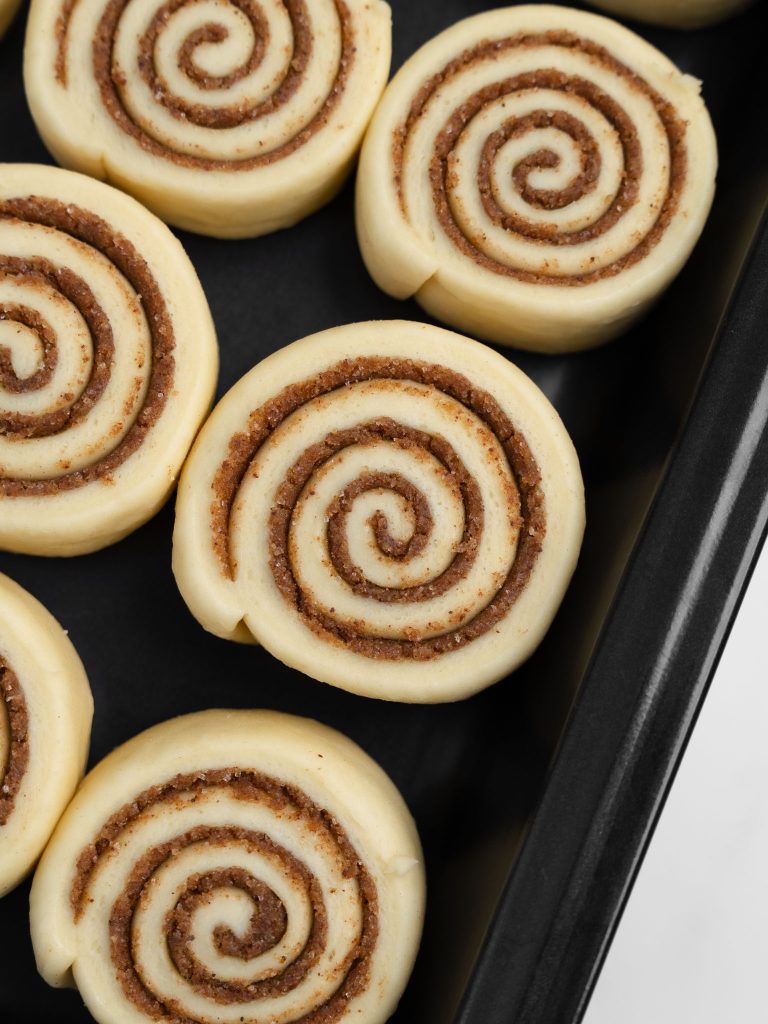






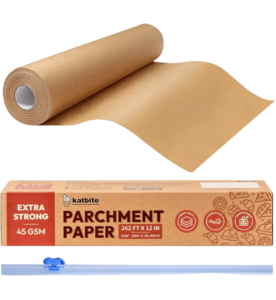



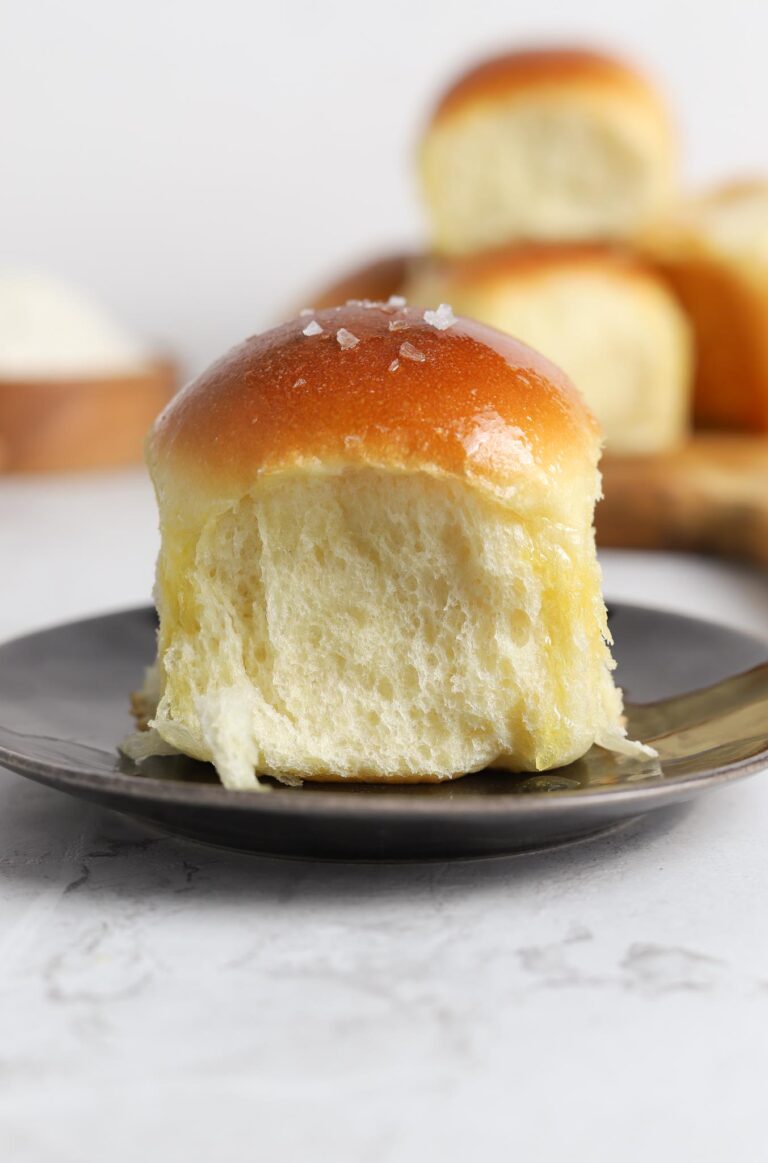


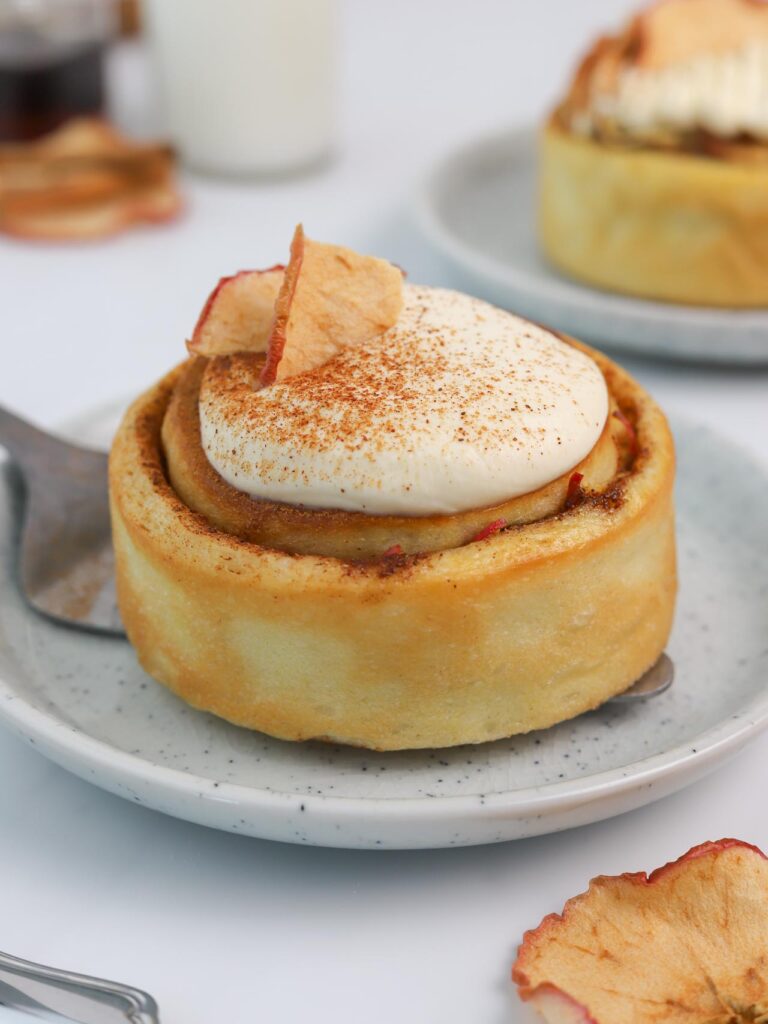
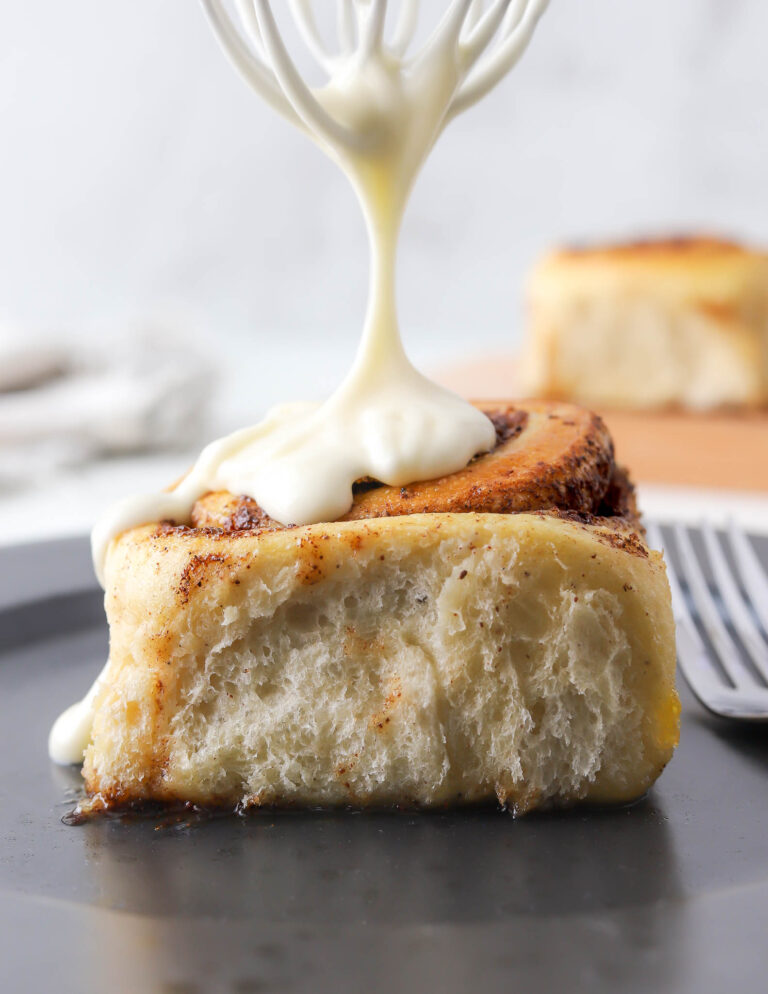

I made the cinnamon rolls and they were delicious. I was disappointed that I didn’t get as lofty a rise out of the dough as I would have liked.